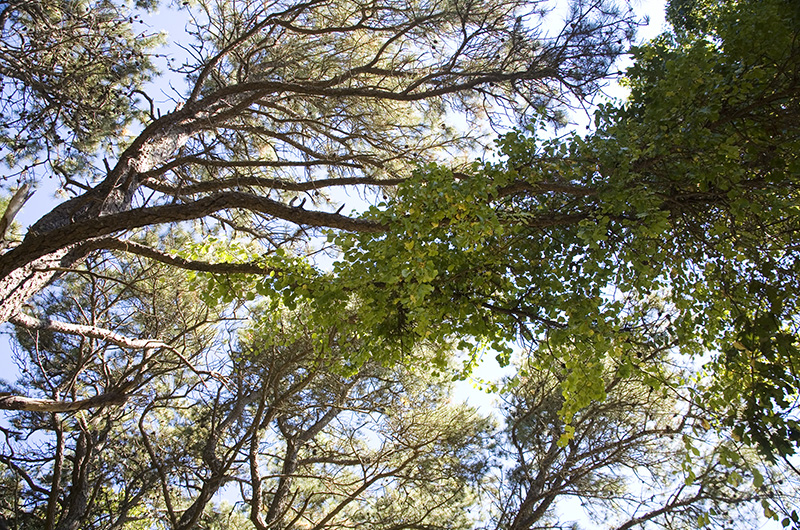As with certain human visitors who wear out their welcome, Martha’s Vineyard hosts many invasive plant pests: purple loosestrife, Norway maple, Russian olive, phragmites, some miscanthus, even the occasional ailanthus tree. But the grand champion of the invaders is Oriental bittersweet, Celastrus orbiculatus.
Simply put, bittersweet is evil. While many non-native flora can take out the competition, bittersweet vines actually strangle anything within reach. Other invasives, like honeysuckle bush or multiflora rose, are like herbaceous Paris Hiltons: attractive but useless, and we’re all a little poorer for their presence. Bittersweet is a botanic version of John Carpenter’s The Thing: It’s murderous and it’s on the move, slithering along fences, clawing its way up doomed trees, girdling its victims, orange roots oozing along underground, ready to pop up and destroy our entire botanic civilization.
Don Brown of New Leaf Custom Gardening in Vineyard Haven says, “Bittersweet is one of the most aggressive species I have to deal with.It can establish quickly and easily, choking out shrubs and overrunning trees.” When a friend heard how bittersweet attacks and kills a mature tree in a matter of a few years, she exclaimed, “Are people aware of this?” Sadly, not enough.
I became familiar with bittersweet while working for The Trustees of Reservations on Misery Island off the Salem coast. I was officially the island manager, but with invasives overrunning the ninety-acre jewel, my real job was to kill plants. So I hacked at honeysuckle, lopped barberry, and offed Norway maples by the dozen. I even kept unruly natives like sumac and poison ivy in line. But no other plant consumed my time like bittersweet, suffocating majestic trees and encroaching on trails at a nauseating pace. It’s easy to identify: The vines, which can grow to several inches in diameter, produce roundish, waxy, alternating leaves about the size of a half dollar. During the growing season, the pale green tendrils extend, grasping at anything within reach. In the fall, the foliage turns a cheery yellow, and the bright red seeds emerge from yellow husks. Adding to its insidiousness, it’s an attractive plant, often used by the unaware in dried floral arrangements.
Judith Villa, co-owner of Working Earth Organic Gardening and Landscaping in Edgartown, cites bittersweet as the most problematic invasive. She estimates that bittersweet is a problem for 25 percent of her clients, particularly those in rural areas and with wetter soils, like on Chappy. As is typical with invasive species, organisms that keep it in check in its native Asia are absent here, allowing it to flourish. “Not that much keeps it from growing,” notes Judith. “The roots travel underneath your lawn and can start popping up.”
Don Brown warns that it’s adaptable to a wide range of growing conditions and has a tremendous growth rate. “There is no such thing as ‘a little bittersweet.’ Either you have it or you don’t.”
And here on the Vineyard, bittersweet is popping up everywhere, particularly in “disturbed areas” like those where people live, spread primarily by birds that ingest its red berries, but also by careless folks who spread the seeds in a variety of ways, through using the vines as seasonal décor, or by carelessly disposing of yard waste. Don knows of at least one instance of contaminated wood chip mulch that contained bittersweet from yard waste.
Suzan Bellincampi, director of the Felix Neck Wildlife Sanctuary for the Massachusetts Audubon Society, can attest to the damage bittersweet can do; she names it as the worst of the plant pests she faces. A former farm, Felix Neck is infested with bittersweet, forcing Suzan to pick and choose which habitats are worth the effort of bittersweet removal, and which are too far gone. “It [bittersweet] creates a monoculture, and plant diversity goes down to zero,” she says. But not only are trees at risk: Studies have shown that wildlife diversity, including bird variety, is greater in areas featuring native vegetation. Interestingly, Oriental bittersweet can hybridize with native bittersweet, degrading the genetic purity.
The good news is: This vegetation terrorist can be had. Unlike kudzu down South, which typically forces landowners to sell their property and move north to escape, bittersweet is vulnerable. Smaller vines can and should be pulled out by hand, roots and all, and dried out before disposal. Large vines should be cut at the base in the spring and early summer, weakening the plant when its root reserves are lowest, and before the vine has produced seeds that could be spread by removal. “It’s a seed-making machine!” says Don, who counsels care with the vines you remove, lest you end up “driving all over the Island with bittersweet seeds flying everywhere – like a macabre Johnny Appleseed.” Cutting vines immediately provides relief to infested trees. According to Judith, even badly infested trees can recover.
After cutting vines, repeated manual control, such as mowing over affected areas, is necessary. If used carefully, concentrated weed killer such as Roundup can be a big help for larger infestations. Apply it to freshly cut stumps to kill the root, or to foliage when new growth appears at the site. Don suggests starting with a minimum amount of weed killer and allowing ample time for it to work – ten to fourteen days. Seeds remain viable for up to five years, so even after initial victory is declared, vigilance is required. As with any protracted conflict, do not foolishly declare ‘mission accomplished’ too soon. “You have to be persistent,” declares Judith.
However you choose to kill bittersweet, do it now. And then keep at it, because it’s a lot easier to quell a small bittersweet insurgency today than a large one tomorrow. Beat back the barbarians, and help in a small way to restore our besieged ecosystem. “It’s a threat to the natural beauty of the Island,” says Suzan.





